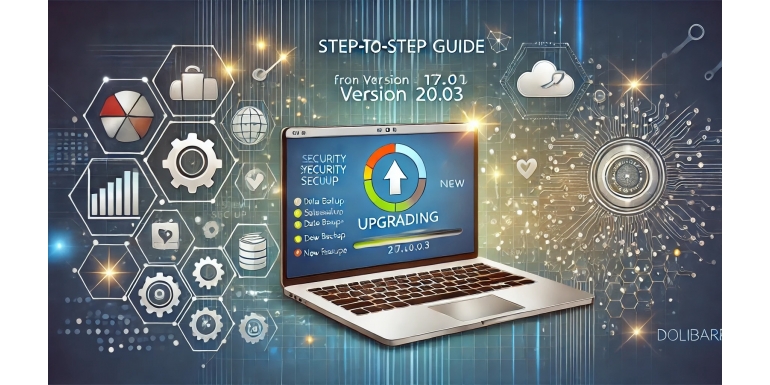
Introduction
Dolibarr is a highly popular open-source ERP/CRM among small and medium-sized businesses. Its modular architecture and flexibility make it an ideal choice for business management. However, to benefit from the latest features, security fixes, and performance improvements, it is crucial to keep Dolibarr up to date.
This detailed guide will walk you through all the steps to update Dolibarr from version 17.0.0 to 20.0.3, minimizing risks and ensuring a smooth transition.
1. Prerequisites Before the Update
Before proceeding with the update, make sure you meet the following conditions:
-
Have a complete backup: Make a copy of your database and Dolibarr files.
-
Check the minimum requirements: Ensure that your server meets the requirements for version 20.0.3.
-
Disable third-party modules: Some modules may not be compatible with the new version.
-
Have SSH access (if necessary): If you are updating on a remote server, SSH access will facilitate the process.
2. Backing Up Dolibarr
Before any update, it is crucial to perform a complete backup of your Dolibarr instance.
2.1. Database Backup
Use the following command to export the MySQL/MariaDB database:
mysqldump -u user -p password dolibarr_db > backup_dolibarr.sql2.2. Backup Dolibarr Files
Copy the entire Dolibarr folder:
tar -czvf backup_dolibarr.tar.gz /path/to/dolibarr/Store these backups in a safe place before proceeding.
3. Updating Dolibarr
3.1. Downloading the New Version
Go to the official Dolibarr website and download version 20.0.3:
wget https://sourceforge.net/projects/dolibarr/files/Dolibarr%20ERP-CRM/20.0.3/dolibarr-20.0.3.tgz3.2. Extracting and Replacing Files
Extract the archive and replace the old Dolibarr files:
tar -xzvf dolibarr-20.0.3.tgz
mv dolibarr-20.0.3 /path/to/dolibarr/3.3. Updating the Database
Access the Dolibarr web interface and follow the update wizard, which will apply the necessary changes to the database.
4. Post-Update: Tests and Verifications
4.1. Checking Log Files
Check Dolibarr logs to identify any potential errors:
tail -f /var/log/dolibarr.log4.2. Reactivating Third-Party Modules
If you use custom modules, enable them one by one and test their compatibility.
4.3. Functional Tests
-
Creating clients
-
Issuing invoices
-
User login
-
Checking the display and dashboards
5. Conclusion
Updating Dolibarr from version 17.0.0 to 20.0.3 brings performance improvements, new features, and essential security fixes. By following this guide, you ensure a smooth transition while minimizing the risk of data loss or software incompatibility.
If you encounter any issues, do not hesitate to consult the official documentation or the Dolibarr community for assistance.
